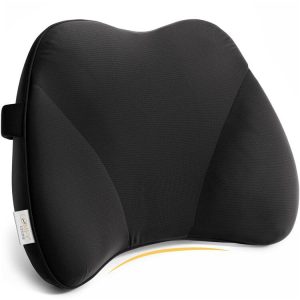
As we all know, jumping rope on its own, is a great way to exercise, and even greater to add to any workout! However, many people, especially beginners, often run into some lower back pain. This could be due to a lot of reasons ranging from tight muscles, weak joints, poor posture, and even a weak core.
With all these possible causes, it can be hard to pinpoint the cause of your lower back pain without the help of medical or health professionals
Why Does My Lower Back Hurt After Jumping Rope?
The most common reason for lower back strain are weak lower body muscles and joints and improper form. Due to its high impact nature, jump rope puts pressure on your lower body's joints, like your knees, and your spine every time you hit the ground. To add to that, the extra strain in the feet all the way up to the core when jumping back up.
However, every body is different. Therefore, there could be other less likely causes affecting you. For instance, it may be a lack in stretching, previous injuries especially in the spine and hips, and even stress and fatigue.
All these factors can make it a little harder to pinpoint the cause of your back pain without medical advice. Luckily for you, we've got you covered!
How Can You Jump Rope Without Hurting Your Back
As with any exercise, a stretching routine should be performed before anything else. A minimum of 5 minutes is recommended for lighter workouts. However, if your muscles, especially on the hips and back, feel tight or strain easily, stretching for 10-15 minutes would be best.
Proper form and equipment should also be another primary focus. Most beginners think that with jump rope, the only equipment to worry about is the rope itself. However, there's another one that is often less thought about, and that's your shoes!
Shoes are important because they act as your joint's first line of defense and support against the high and continuous impact jumping rope puts them through so make sure that your shoes are comfortable and are specifically made for exercises (avoid slipper and flats!)
When it comes to proper form, a common misconception first-timers have is that it's only about keeping your shoulders back and straight and your head up. While posture is EXREMELY important to keep yourself from injuring your spine, it will not provide your back the sufficient amount of support it requires while jumping rope or performing any high impact workout. You will also need to support your lower back with your core.
Keeping a tight and active core will provide extra support for your lower back. This may be hard for those who are new to jumping rope or high impact workouts as you will have to absorb pressure from every hitting the ground after every jump and keep a steady breath while keeping a tight core at the same time! However, with even just a day or two's practice, you should be able to nail it!
Remember to always be mindful of your body and listen to any sign of discomfort or possible injuries.
Jump Rope Mistakes To Avoid For A Strong Lower Back
There are a few main habits or movements to avoid in order to prevent the horror of an even slightly injured back while jumping rope, there are a few things you need to remember. The first being to avoid arching your back! This is because landing on an arched back, especially while jumping rope, causes a lot of strain on your back which will no doubt cause back pain and may lead to permanent damage.
Along with that, another mistake to avoid is hunching your shoulders. This is often seen in people new to jumping rope. This is often caused by the natural feeling of needing wider clearance for the rope to go over you. Avoid bending your head down and looking at the ground as this may cause you to unconsciously hunch your shoulders causing more strain on the upper back.
The next thing on our list, is to avoid slapping your feet on the ground. This is because landing on your heel, especially, causes your back to take in more pressure on the ground. In jump rope, you should always land on your toes for better shock absorption, balance, and safety.
Lastly, in jump rope, you should also avoid extending your arms too far from the body. This ensures that you don't hit yourself with the rope and also prevents back pain. Though this may not seem like a big deal, holding the jump rope to wide shortens the vertical jumping space which will naturally force your body to hunch over to compensate for the shorter clearance every time you jump.
Keeping your arms in will also help you properly target upper body muscles without risking pain and soreness in the back and wrist joint areas which are often the complaints of beginners in jumping rope. Often times, wrist and arm soreness or pain are caused by having too wide of a spread on the rope.
The last, and most important, thing NOT to do is participating in jump rope with any pre-existing injuries that may worsen with physical activity. If you are feeling any unusual level of discomfort while jumping rope, or have been experiencing any body ache or pain, do not jump rope and stay away from any high impact exercise or workout without checking with a medical or health professional and getting their advice, or treatment if needed, first.
Remember, we jump rope for fitness, and there is no fitness without health!
FAQs
How can I jump rope without hurting my back?
Here are five things to remember when jumping rope:
- Land on your toes to ensure a softer landing that is supported by your legs, glutes, calves, and core to protect your lower back from the impact.
- Maintain proper posture. Remember; shoulders back, chest out, spine straight, knees slightly bent, and arms not too far from your sides.
- Engage those abs! One of the best tips to take is to make sure you are constantly supporting your back with your abs too by keeping them nice and tight as you're jumping.
- Never skip stretching! To avoid injuries and warm your body up, properly stretch your whole body (yes, even your foot!). Not only will this keep you safe, it will also make you feel free as a bird as you jump.
- Get proper equipment! Remember to test your compatibility with your ropes length, wear proper shoes, and ensure your clothing is short enough to avoid catching on the rope.
How to prevent jumping rope injuries?
- Do not arch your back. Practice keeping a straight back with an engaged core before doing heavy volumes of jumping. As with other sports, it will take some practice to get everything perfect!
- Jump rope on a hard and stable surface such as concrete. As tempting as it might be, do not jump rope on a foam covered surface. This keeps you from possible joint or muscle related injuries.
- Do not jump rope with any pre-existing injuries. Check with your doctor if unsure whether or not you are healthy enough or about your level of fitness.
- Remember that jumping rope, and even just jumping in itself, is a form exercise, workout, and sport. This means that it also puts strain or even stress on your muscles and joints. Always stretch beforehand, listen to every tip given by your doctor, and fuel your body enough to compensate for the level of activity you'll be doing.
- Keep away from doing jump rope in rooms with low ceilings to prevent any damage or accidents. If you have access to a gym or an open field or court, do your jumping there!
Is jump rope better than running?
Jumping rope and running are two very different exercise with quite similar benefits. For one thing, both are low cost and equipment exercises that burn calories quickly and efficiently while using multiple groups of muscles. Both are also exercises that can be performed as an aerobic and anaerobic workout depending on your goal.
However, they do have some differences and individual advantages.
For instance, both work the lower body muscles but running exerts a higher level strain on the legs and glutes with minimal upper body exertion while jumping rope exerts a moderate amount of strain on the legs and glutes but involves resistance training on the upper body muscles such as the shoulders, triceps, and back.
For those who are looking for an adaptable full body exercise, jumping rope is definitely the better choice!
Conclusion
Jumping rope is, without a doubt, one of the best full body exercises out there. It is low cost, adaptable, efficient, and safe workout suitable for anyone from beginners to pros. Especially in the this time of the new normal, jump rope is one of the best and most popular options for those who prefer to stay at home.
It's also practical as it doesn't require hours of performance to make a significant effect leaving you lean and toned with only sacrificing a few minutes of your day!







